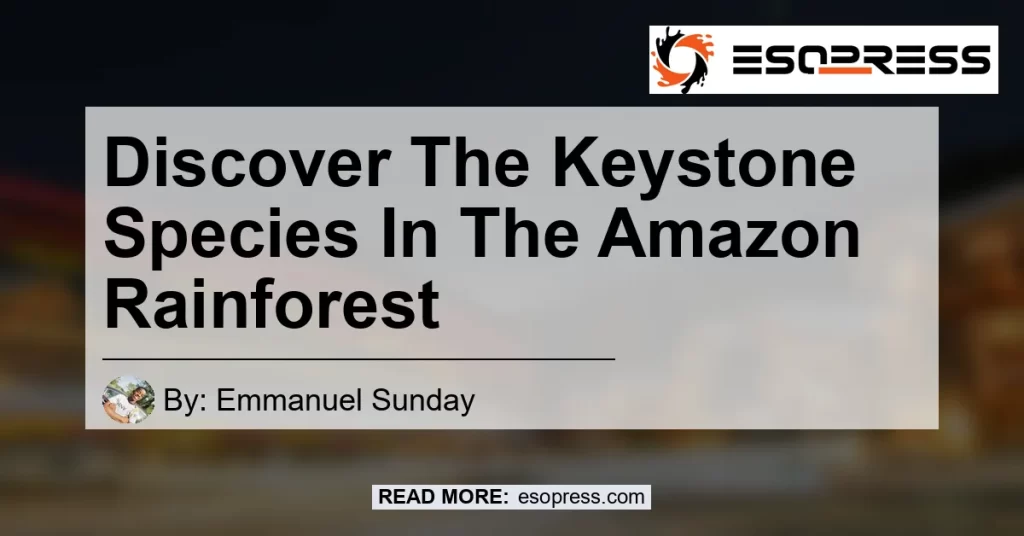

The Amazon rainforest is a vast and diverse ecosystem, home to numerous plant and animal species. Within this ecosystem, there are certain species that play a crucial role in maintaining the balance and health of the environment. These species are known as keystone species. In this article, we will explore the keystone species in the Amazon rainforest, their importance, and their impact on the ecosystem.
Contents
What are Keystone Species?
Keystone species are species that have a disproportionately large impact on their environment relative to their abundance. They play a crucial role in maintaining the structure and functioning of an ecosystem. The removal or decline of a keystone species can have cascading effects on the entire ecosystem.
Keystone Species in the Amazon Rainforest
The Amazon rainforest is known for its incredible biodiversity, with millions of species coexisting in harmony. Within this complex ecosystem, several species have been identified as keystone species. Let’s take a closer look at some of them.
The Agouti: The Seed Spreader
One of the keystone species in the Amazon rainforest is the agouti. This small rodent is nicknamed the “seed spreader” due to its unique behavior of burying seeds for later consumption. This behavior helps to disperse seeds across the forest floor, aiding in the regeneration of plants.
The agouti’s role in seed dispersal is crucial for the biodiversity and sustainability of the Amazon rainforest. By burying seeds, the agouti helps to prevent them from being consumed by predators and provides them with an opportunity to germinate and grow. Without this important seed-spreading mechanism, many plant species in the Amazon rainforest would struggle to regenerate.
The Tapir: The Forest Gardener
Another keystone species in the Amazon rainforest is the tapir, specifically the South American tapir. This large land mammal plays a vital role in maintaining the health of the forest by acting as a “gardener.” The tapir consumes large quantities of fruits and disperses the seeds through its feces.
The tapir’s role as a forest gardener is crucial for the growth and dispersal of plants in the Amazon rainforest. By consuming fruits from different plant species, the tapir helps to disperse their seeds over larger distances, providing them with a better chance of finding suitable growing conditions. This process contributes to the overall diversity and resilience of the ecosystem.
The Brazil Nut Tree: The Provider
One of the most well-known keystone species in the Amazon rainforest is the Brazil nut tree. This towering tree is not only an iconic symbol of the rainforest but also plays a key role in its ecological balance. The Brazil nut tree relies on a specific species of bee for pollination, and its seeds are dispersed by agoutis.
The Brazil nut tree’s dependence on specific pollinators and seed dispersers makes it a keystone species in the Amazon rainforest. Its presence ensures the survival and propagation of other plant and animal species that rely on its nuts for food and shelter. The loss of the Brazil nut tree would have significant ecological implications for the entire Amazon rainforest.
Other Keystone Species
While the agouti, tapir, and Brazil nut tree are some of the most well-known keystone species in the Amazon rainforest, there are several others that also play important roles. These include the Black-rumped Agouti, Red-rumped Agouti, and Black Agouti, which are widely distributed in the rainforest and contribute to seed dispersal.
The Importance of Keystone Species
Keystone species are crucial for maintaining the balance and health of ecosystems. Their presence helps to regulate populations, disperse seeds, pollinate plants, and maintain the overall biodiversity of an area. Without keystone species, the structure and function of an ecosystem can be severely disrupted.
In the case of the Amazon rainforest, the presence of keystone species ensures the long-term survival and sustainability of the ecosystem. Their interactions and contributions to seed dispersal and pollination promote the growth of new plants, which in turn provide food and shelter for a wide range of animal species.
The Impact of Keystone Species Loss
The loss or decline of keystone species can have cascading effects on the entire ecosystem. Without their presence, certain plant species may struggle to reproduce, leading to a decline in their population. This can disrupt the food chain and affect the abundance of other species that rely on those plants for sustenance.
In the Amazon rainforest, the loss of keystone species like the agouti, tapir, and Brazil nut tree would have significant consequences. The reduced seed dispersal and pollination services provided by these species would result in decreased plant diversity and impair the overall health of the rainforest. This, in turn, would impact the many animals that depend on these plants for food and habitat.
Conclusion
The keystone species in the Amazon rainforest play a vital role in maintaining the balance and health of this unique ecosystem. From the agouti’s seed-spreading activities to the tapir’s role as a forest gardener, these species ensure the survival and propagation of many plants and animals in the rainforest.
Among the keystone species discussed, the Brazil nut tree stands out for its iconic status and its dependence on specific pollinators and seed dispersers. The loss of this keystone species would have far-reaching consequences for the entire Amazon rainforest.
To fully appreciate the significance of these keystone species and the Amazon rainforest’s delicate balance, it is important to support conservation efforts. By safeguarding these habitats and protecting the keystone species within them, we can help ensure the long-term survival of one of the world’s most remarkable ecosystems.
Best Recommended Product: National Geographic: The Amazon – The World’s Largest Rainforest


Disclaimer: The product recommendation above is for informational purposes only. We do not endorse or guarantee the quality or effectiveness of the product. Please do your own research and consider all factors before making a purchase.






